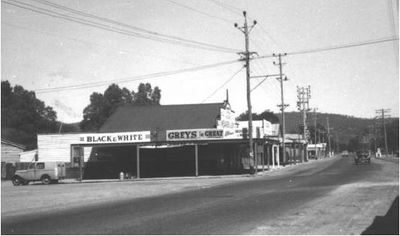George Conway MID
From Our Contribution
 | |
 Conway's store 1965 Cnr Albany road and Dorothy street | |
| Personal Information | |
|---|---|
| Date of Birth | Not known |
| Place of Birth | London, England |
| Death | 21 Feb 1934, aged 52 |
| Place of Death | Gosnells, Western Australia |
| Age at Enlistment | 34 years, 5 months |
| Description |
5'3¾" (1.62m) tall ; 112lbs 50.802 kg ; sallow complexion ; grey eyes ; dark brown hair |
| Occupation | Labourer |
| Religion | Church of England |
| Address | Station road, Gosnells, Western Australia |
| Next of Kin | Wife , Mrs M C Conway |
| Military Information | |
| Reg Number | 4264 |
| Date of Enlistment | 8 Sep 1915 |
| Rank | Lance Corporal |
| Unit/Formation | 16th Battalion, 13th Reinforcement, transferred to 48th Battalion |
| Date of Embarkation | 29 Jan 1916 ‒ 26 Feb 1916 |
| Ship Embarked On | HMAT A54 Runic |
| Date of Return | 5 Nov 1917 ‒ 23 Dec 1917 |
| Ship Returned On | HMAT A32 Themistocles |
| Fate |
Wounded in action 22 Jan 1917 Returned to Australia - medical Mentioned in Despatches AWM |
| Monument |
Gosnells RSL Honour Board Gosnells Primary School Honour Roll |
| Medals |
British War Medal Victory Medal Mentioned in Despatches |
Pre War
Previous service in England with the Royal Naval Reserve (7 years). George had married Mary Catherine Stephens in Neath, Wales in December 1907. They had three children, Doris, Albert and Margaret.
Electoral Roll entries: 1913 - 1917 Station road, Gosnells, farmer
War Service
Entered camp on 8 Sep 1915, before being allocated to the 13th reinforcement draft for the 16th Battalion on 13 Nov 1915, and so travelled to Egypt with the draft. On 2 Apr 1916 as part of the AIF reorganisation and doubling in size in Egypt, he was transferred to the 48th Battalion. Following a period of training and defending the Suez Canal, during the evening of 1 Jun 1916 they travelled by rail from Serapeum to Alexandria where they boarded HMT Caledonia. At sea from 4 - 9 Jun, they were bundled into horse railway carriages and sent to northern France. A journey that took several days.
On 31 Jan 1917 George was appointed Lance Corporal, but was wounded in action soon after on 21 Feb 1917. The unit's War Diary says little about the action but "The Story of a Battalion-Being a record of the 48th Battalion, A.I.F." by W Devine tells us that an attack on German lines that occurred on the night of the 22nd without the assistance of Artillery. Misconceived, it failed but fortunately there were only three minor casualties. George being one of them, receiving a gunshot wound to his right shoulder. Given that George was Mentioned in Despatches we can assume that it was for his participation in the stunt, and that the correct date for his wounding is therefore 22 Feb 1917.
Admitted to the 18th General Hospital in Camiers after being treated by the 12th Australian Field Ambulance, he was evacuated to England aboard HS Stad Antwerpen from Calais on 28 Feb 1917 he was admitted to the 3rd Australian General Hospital in Brighton the same day. From 18 Apr - 3 May 1917 he enjoyed a furlough in England. Following his return to duty he moves about bases in England until it is decided to send him home on medical grounds - chronic rheumatism and general Debility.
Discharged by the 5th Military District on 8 May 1918.
Award Comment
Recommended 5 Mar 1917. Awarded and Promulgated 'London Gazette', second Supplement, No 30107 (1 Jun 1917) & 'Commonwealth Gazette', No 169 (4 Oct 1917).
Post War
From 1923 - 1930 George was the Gosnells Postmaster, operating out of his store on the corner of Albany road, and Dorothy street. George died on 21 Feb 1934 with his death attributed to war time injuries. His store was run by his children until it was sold in the 1950s. Mary died in 1972 in Mt Lawley.
Notes